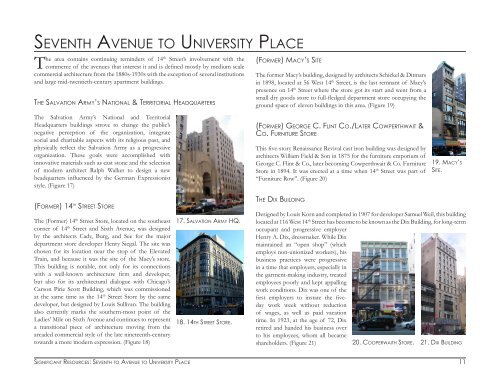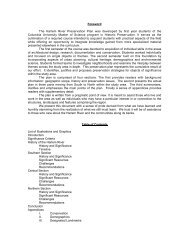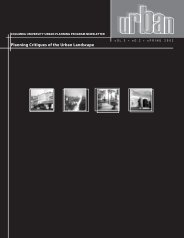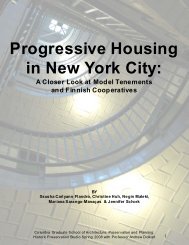14th street and union square preservation plan - Columbia ...
14th street and union square preservation plan - Columbia ...
14th street and union square preservation plan - Columbia ...
Create successful ePaper yourself
Turn your PDF publications into a flip-book with our unique Google optimized e-Paper software.
SEVENTH AVENUE TO UNIVERSITY PLACE<br />
The area contains continuing reminders of 14 th Street’s involvement with the<br />
commerce of the avenues that interest it <strong>and</strong> is defined mostly by medium scale<br />
commercial architecture from the 1880s-1930s with the exception of several institutions<br />
<strong>and</strong> large mid-twentieth-century apartment buildings.<br />
THE SALVATION ARMY’S NATIONAL & TERRITORIAL HEADQUARTERS<br />
The Salvation Army’s National <strong>and</strong> Territorial<br />
Headquarters buildings strove to change the public’s<br />
negative perception of the organization, integrate<br />
social <strong>and</strong> charitable aspects with its religious past, <strong>and</strong><br />
physically reflect the Salvation Army as a progressive<br />
organization. These goals were accomplished with<br />
innovative materials such as cast stone <strong>and</strong> the selection<br />
of modern architect Ralph Walker to design a new<br />
headquarters influenced by the German Expressionist<br />
style. (Figure 17)<br />
(FORMER) MACY’S SITE<br />
The former Macy’s building, designed by architects Schickel & Ditmars<br />
in 1898, located at 56 West 14 th Street, is the last remnant of Macy’s<br />
presence on 14 th Street where the store got its start <strong>and</strong> went from a<br />
small dry goods store to full-fledged department store occupying the<br />
ground space of eleven buildings in this area. (Figure 19)<br />
(FORMER) GEORGE C. FLINT CO./LATER COWPERTHWAIT &<br />
CO. FURNITURE STORE<br />
This five-story Renaissance Revival cast iron building was designed by<br />
architects William Field & Son in 1875 for the furniture emporium of<br />
George C. Flint & Co., later becoming Cowperthwait & Co. Furniture<br />
Store in 1894. It was erected at a time when 14 th Street was part of<br />
“Furniture Row”. (Figure 20)<br />
19. MACY’S<br />
SITE.<br />
(FORMER) 14 TH STREET STORE<br />
The (Former) 14 th Street Store, located on the southeast<br />
corner of 14 th Street <strong>and</strong> Sixth Avenue, was designed<br />
by the architects Cady, Burg, <strong>and</strong> See for the major<br />
department store developer Henry Siegal. The site was<br />
chosen for its location near the stop of the Elevated<br />
Train, <strong>and</strong> because it was the site of the Macy’s store.<br />
This building is notable, not only for its connections<br />
with a well-known architecture firm <strong>and</strong> developer,<br />
but also for its architectural dialogue with Chicago’s<br />
Carson Pirie Scott Building, which was commissioned<br />
at the same time as the 14 th Street Store by the same<br />
developer, but designed by Louis Sullivan. The building<br />
also currently marks the southern-most point of the<br />
Ladies’ Mile on Sixth Avenue <strong>and</strong> continues to represent<br />
a transitional piece of architecture moving from the<br />
arcaded commercial style of the late nineteenth-century<br />
towards a more modern expression. (Figure 18)<br />
17. SALVATION ARMY HQ.<br />
18. 14TH STREET STORE.<br />
THE DIX BUILDING<br />
Designed by Louis Korn <strong>and</strong> completed in 1907 for developer Samuel Weil, this building<br />
located at 116 West 14 th Street has become to be known as the Dix Building, for long-term<br />
occupant <strong>and</strong> progressive employer<br />
Henry A. Dix, dressmaker. While Dix<br />
maintained an “open shop” (which<br />
employs non-<strong>union</strong>ized workers), his<br />
business practices were progressive<br />
in a time that employers, especially in<br />
the garment-making industry, treated<br />
employees poorly <strong>and</strong> kept appalling<br />
work conditions. Dix was one of the<br />
first employers to instate the fiveday<br />
work week without reduction<br />
of wages, as well as paid vacation<br />
time. In 1923, at the age of 72, Dix<br />
retired <strong>and</strong> h<strong>and</strong>ed his business over<br />
to his employees, whom all became<br />
shareholders. (Figure 21)<br />
20. COOPERWAITH STORE. 21. DIX BUILDING<br />
SIGNIFICANT RESOURCES: SEVENTH TO AVENUE TO UNIVERSITY PLACE<br />
11
















